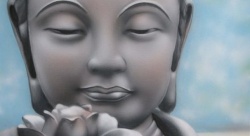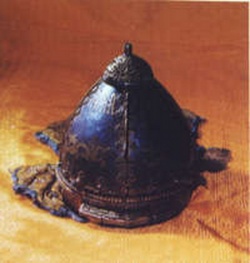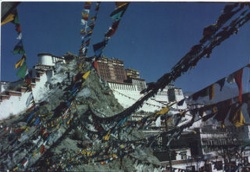Dharma from the sky II: Indian or Chinese dharma?
In the last post we looked at the story of the earliest appearance of the dharma in Tibet.
According to the story, a casket fell out of the sky onto the roof (or before the feet) of the early king Lhatotori.
What Lhatotori found when he opened the casket differs in the various accounts, but is usually includes a well-known sutra, the Karaṇḍavyūha.
This sutra is dedicated to the bodhisattva Avalokiteśvara, the embodiment of compassion in the world, and introduced the six syllable mantra of Avalokiteśvara that was to become so popular in Tibet: Om maṇi padme huṃ (see my earlier post).
The casket is usually also said to include a more obscure text which is known by a strange variety of names.
In the later histories, and the canonical versions of the prayer, the name of the prayer is the fully Tibetan Spang skong phyag brgya pa (The 100 Salutations Repairing Breaches).
However in earlier histories like Sönam Tsemo’s Introduction to the Dharma, Butön’s Dharma History and the Maṇi Kambum the name of the prayer is Pang kong phyag rgya pa (The Pangkong Mūdras).
Here the first two syllables appear not to be Tibetan, but rather approximations of syllables from another language. Some other early histories, including Nyangral Nyima Özer’s Essence of Flowers and the Accounts of Ba give yet another name: Mu tra’i phyag rgya (The Mūdras of the Mūdras!).
The text itself as preserved in the Tibetan canon is a prayer of homage and confession beginning with a hundred and eight homages directed toward a variety of buddhas, dharma texts and objects, and the sangha of bodhisattvas and arhats. It ends with prayers of offering, confession, and aspiration. This is not an unusual sort of text, so why has it been called by so many different names?
Thankfully we can make sense of this confused situation with the help of the Dunhuang manuscripts, for this prayer seems to have been rather popular before the 11th century.
It usually appears in manuscipt collections of prayers that were probably put together for group recitation in monasteries. The fullest title given in the Dunhuang versions is Pam kong brgya rtsa brgyad (IOL Tib J 315.1/4). In other versions it is shortened to Pām kong brgya rtsa (Pelliot tibétain 184) and simply Pang kong (Pelliot tibétain 98).
The first part (pam/pang kong) is certainly a transcription, and it sounds much more like a transcription of a Chinese term than a Sanskrit one. The kong is very likely Chinese gong 供 which in Buddhist Chinese means an act of worship or offering, equivalent to the Sanskrit pūja. I have not found such a clear match for the pam/pang part, but one possibility is ban 昄, meaning ‘extensive’.
The Tibetan part of the title in the Dunhuang manuscript (brgya rtsa brgyad) means ‘one hundred and eight’, which makes perfect sense in that the prayer contains a hundred and eight homages. Therefore the alteration of this in the histories and canonical versions to phyag (b)rgya pa looks like a corruption.
It appears that the other strange version of this title, Mu tra’i phyag rgya (The Mūdras of the Mūdras), was an attempt to make the text seem more Indian and less Chinese by replacing the pang kong part with the Sanskrit word mūdra. But since that word mūdra was just a translation of the (already corrupted) second part of the title, the result was not at all convincing.
The most convincing early title of our text (Pam kong brgya rtsa brgyad) suggests a text either translated from Chinese, or composed in a Sino-Tibetan culture like that of Dunhuang.
If we can draw a moral from this little philological enquiry, it may be that the presence of a Chinese text along with more well-known Indian ones in Lhatotori’s casket is emblematic of the mixed sources from which early Tibetan Buddhism was made. While Chinese Buddhist sources never truly featured as importantly as Indian ones, they were there, and China was certainly not spurned as a source of authentic dharma before the 11th century (notwithstanding a certain debate at Samyé), as it often would be later.
Tibetan sources
1. Anonymous. Dba bzhed [Accounts of Ba]. In Wangdu, Pasang & Hildegarde Deimberger. Dba’ bzhed: The Royal Narrative concerning the bringing of Buddha’s Doctrine to Tibet. Vienna: Verlag der Österreichischen Akademie der Wissenschaften. [p.25]
2. Anonymous. Ma ṇi bka’ ‘bum (Maṇi Kambum).
The Punakha redaction edited by Jamyang Samten. New Delhi, 1975. [vol.I (e), ff.100b.3, 184a.3]
3. Bsod nams rtse mo. Chos la ‘jug pa’i sgo [An Introduction to the Dharma). In Sa skya bka’ ‘bum. [vol.I, p.50a.6] 4. Bu ston rin chen grub. Chos ‘byung gsun rab rin po che mdzod (History of Buddhism). Beijing: Khrung go bod kyi shes rig dpe skrun khang. 1988. Translation in Obermiller, E. 1931-2. The history of Buddhism (Chos ḥbyung) by Bu-ston. I The Jewellery of Scripture, II The history of Buddhism in India and Tibet. Heidelberg: O. Harrosovitz. Reprint 1986 New Delhi: Sri Satguru Publications. [p.183]
5. Nyang ral nyi ma ‘od zer. Chos byung me tog snying po sbrang rtsi’i bcud (Essence of Flowers). In Schuh, Dieter. Die grosse Geschichte des tibetischen Buddhismus nach alter Tradition rÑiṅ ma’i chos byuṅ chen mo. Sankt Augustin: VGH Wissenschaftsverlag. [f.173b.4]


